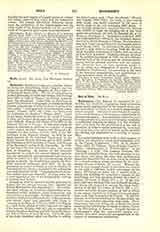

Endlicher, STEPHAN LADISLAUS.—Austrian botanist (botanical abbreviation, Endl.), linguist, and historian, b. at Pressburg, Hungary, June 24, 1804; d. at Vienna, March 28, 1849. The son of a physician, he studied philosophy at Pesth and Vienna, and theology from 1823 to 1826 at Vienna; he did not, however, enter the priesthood. From 1826 at Pressburg he turned his attention to languages, studying especially Chinese, a knowledge of which is shown in some of his later works: “Anfangsgründe der chinesischen Grammatik” (Vienna, 1844), and “Atlas von China nach der Aufnahme der Jesuiten” (Vienna, 1843). Urged by his father, Endlicher took up the study of botany in 1826, and devoted all his spare time to it during the years 1828-36, when he had charge of the MSS. in the Imperial Library of Vienna. In this same period he issued as librarian, in addition to a number of works on the ancient classical, German, and Hungarian literatures, the first volume (Vienna, 1836) of the MS. catalogue of the Imperial Library. In 1836, he was made curator of the botanical department of the Royal Natural History Museum, and in 1840, professor of botany at the University of Vienna, and director of the Botanical Garden of the University. In 1830, he had issued his first botanical treatise, that on the flora of Pressburg. As curator of the botanical department he united the various distinct herbaria into one scientifically arranged general herbarium, to which he added, as a gift, his own containing 30,000 species of plants; the classification adopted by Endlicher remained unchanged until 1885. On his appointment as curator he began at once to develop his botanical system, which is explained in his well-known and most important work: “Genera plantarum secundum ordines naturales disposita” (Vienna, 1836-50), a work regarded as one of the fundamental writings of systematized botany.
As early as 1835 he founded the first periodical in Austria for the natural sciences, the “Annalen des Wiener Museums der Naturgeschichte”. His numerous other writings on botanical subjects show an independent critical judgment, acute observation, and comprehensive knowledge. Endlicher also collaborated in a number of publications with other botanists; with Schott, Fenzl, and especially with Unger in “Grundzügeder Botanik” (Vienna, 1843); with Pöppig in a work on the plants of Chile, Peru, and the region of the Amazon (Leipzig, 1835-45); also in conjunction with the American Asa Gray, and with George Bentham and Robert Brown of Great Britain. Up to the time of his death Endlicher aided von Martius in editing the latter’s great work “Flora Brasiliensis” (Munich and Leipzig, 1840-1906); the work, a folio costing 6000 marks, was finally completed in 130 parts of 20,733 pages in all, and containing 3811 plates. It was through Endlicher’s exertions that von Martins was enabled to begin the bringing out of this work under the patronage, and with the financial aid, of the Emperor Ferdinand I. Endlicher’s botanical MSS. and correspondence belong to the botanical department of the Royal Museum at Vienna; his correspondence with Unger was published by the botanist Haberlandt (Berlin, 1899). In addition to his other labors, he had a large share in founding (1846-47) the Imperial Academy of Sciences of Vienna, and was one of its first forty members. Endlicher became involved in the political movement of 1848; he was elected a member both of the German and the Austrian parliaments, but his political activities were not successful. Botanists have, on three occasions, sought to use his name as a designation of species of plants (Endlichera, Endlicheria), but according to the rules of the botanical nomenclature, such appellations express synonyms which should be avoided.
JOSEPH ROMPEL

